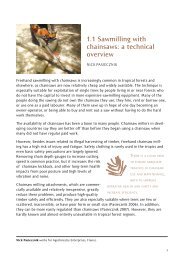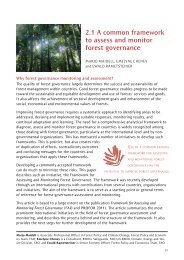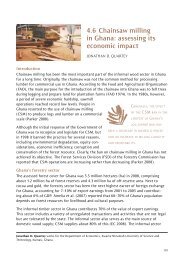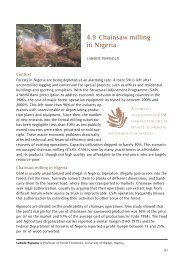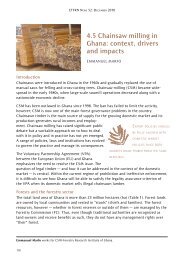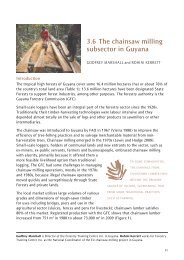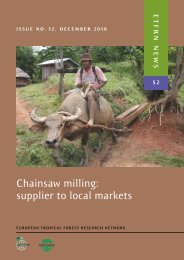Chainsaw milling: supplier to local markets - European Tropical ...
Chainsaw milling: supplier to local markets - European Tropical ...
Chainsaw milling: supplier to local markets - European Tropical ...
You also want an ePaper? Increase the reach of your titles
YUMPU automatically turns print PDFs into web optimized ePapers that Google loves.
5.1 DEvElopiNg TimbER lEgaliTy REgimEs<br />
linking timber legality and governance<br />
The FLEGT/VPA programme<br />
The need <strong>to</strong> change from government control over the forestry sec<strong>to</strong>r <strong>to</strong> decentralized<br />
forest governance is reflected in several programmes <strong>to</strong> stimulate timber legality. one<br />
example is the Eu Forest law Enforcement, Governance, and Trade (FlEGT) action<br />
programme. in order <strong>to</strong> eliminate the import of illegal timber in<strong>to</strong> Europe, the programme<br />
stimulates the formulation of a Voluntary partnership agreement (Vpa) between the Eu<br />
and selected tropical countries that provide timber <strong>to</strong> the <strong>European</strong> market. The Vpa<br />
identifies the national legal framework and compliance moni<strong>to</strong>ring system that ensure<br />
that all timber exports from the country <strong>to</strong> the Eu have been legally acquired, harvested,<br />
transported and exported.<br />
The FlEGT programme explicitly aims <strong>to</strong> combine legal and governance principles<br />
(van bodegom et al. 2008). in order <strong>to</strong> stimulate good forest governance, the programme<br />
supports the formation of multi-stakeholder platforms <strong>to</strong> define national criteria for<br />
timber legality and for moni<strong>to</strong>ring the implementation of legality schemes (<strong>European</strong><br />
Commission 2007). This is expected <strong>to</strong> result in greater transparency and accountability in<br />
forest exploitation and trade.<br />
Different categories of legal principles for forest exploitation<br />
although the FlEGT programme supports both timber legality and good forest<br />
governance, it is not clearly defined whether it is intended <strong>to</strong> stimulate good governance<br />
of the traditional corporate forestry regime or of the newly emerging decentralized<br />
forestry regime. This becomes clear when considering the different types of legal norms<br />
for forest exploitation, which fall in<strong>to</strong> four main categories:<br />
• timber exploitation as an ecologically sustainable practice. important issues include<br />
the cutting of officially assigned timber species and quotas in assigned exploitation<br />
blocks and meeting requirements for damage-controlled logging. requirements<br />
regarding timber tracking throughout the marketing chain are also important in<br />
order <strong>to</strong> prove that the marketed timber has been legally exploited;<br />
• payments of different types of timber duties, including fees for exploitation rights,<br />
stumpage fees, transport fees and export fees;<br />
• fulfillment of social obligations by timber exploitation companies, which traditionally<br />
mainly focus on safe and socially responsible labour conditions. increasingly, they<br />
also concern the social responsibilities of timber exploitation groups with respect<br />
<strong>to</strong> <strong>local</strong> communities — examples are benefit-sharing schemes or reimbursement of<br />
damages <strong>to</strong> community forest resources; and<br />
• forest access rights and benefit sharing by <strong>local</strong> communities. During the past<br />
decades, new policies have been developed for assuring equitable access <strong>to</strong> forest<br />
resources and schemes for forest benefit sharing. These schemes aim not only <strong>to</strong><br />
encourage better forest management, but <strong>to</strong> support more equitable use of forests<br />
and improve the livelihoods of forest-dependent people.<br />
207



